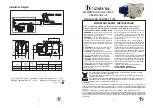
Water balance
Controlling the chemical balance of pool water is vital. The ideal range is slightly on the alkaline
side, between
7.4 and 7.6 on the pH
scale. If the pH is too high (alkaline), disinfectants are less
effective in destroying bacteria and algae; water will be cloudy, scale can develop and the filter
can be blocked. If the pH is too low (acidic), it will cause eye and skin irritation, corrosion of
metal parts, and etching and discoloration. Because over acidity can be the most serious, do not
allow the pH to get below 7.2.
Testing pH
is simple. The water sample in the test kit will change color according to the pH.
During the summer, the pH should be tested three times a week. Always test for pH after a
storm or at other times when large quantities of contaminants have been carried into the water.
Contact your pool company for chemicals to raise or lower the pH of the pool water.
Disinfecting the pool water
Bacteria are the main cause of unsanitary pool water. These microscopic organisms, some of
them harmful, invade pool water by means of carriers – mostly people. Particularly in pools
with heavy use, bacteria control cannot be overemphasized.
Chlorine
is by far the most popular disinfecting agent. It has proven to be effective and easy to
use.
Add chlorine only in the evening or early morning hours. Keep the filtration system on to
distribute the chlorine in the pool.
Whenever you add chlorine, it immediately goes to work killing algae and bacteria, but in the
process these same algae and bacteria destroy some of it. The amount of chlorine used up in this
manner is the chlorine demand of the water.
The amount of disinfectant left in the water is
referred to as the chlorine residual
.
This
free residual
keeps the pool sanitary, and only a small
amount of it is required.
Pool water also contains ammonia and other compounds of nitrogen, particularly ammonia
nitrogen. Chlorine and ammonia combine to form chloramines which cause the unpleasant odor
often associated with chlorine, particularly pungent if the pH is low.
If you can smell the
chlorine, there isn’t enough residual chlorine in the water
, as chlorine in an uncombined state is
practically odorless.
The chlorine residual, that which is not combined with nitrogen, should never drop below 0.5
ppm it must be ideally
between 0.5ppm and 1.5 ppm
.
Chlorine residual is tested in the same
way as the pH. Follow the instructions on your test kit.
Sunlight, water temperature, heavy pool use, and wind can all deplete the chlorine residual.
Regular use of chlorinated iso-cyanurate should keep the residual at a safe level. But a day of
































